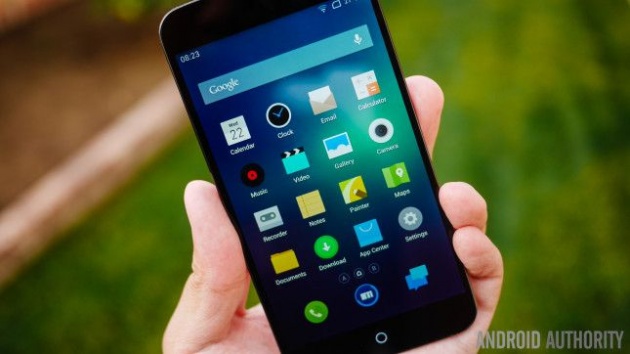Phones from Chinese manufacturers are slowly coming to the west – and at pretty affordable packages. Though perhaps not entirely new at this point, Meizu’s latest flagship phone made us turn our heads – for more than a few reasons.

Plenty of you have pointed out what seems to be the MX3’s source of inspiration – the iPhone and iOS – but all in all the result is still a very attractive phone, inside and out. Featuring a remarkably thin bezel, the black front is interrupted only by a small white circle at the bottom, which works as the home button. Somewhat impressive, Meizu managed to fit a large 5.1 inch display in a very tight form factor, that fits very nicely in the hand.
The rest of the layout puts the volume rocker on the left side and the power button up top – this button layout is not too common in the Android space and took a bit of adaption coming from more popular button layouts. That being said, it’s certainly not that foreign, and you do get used to it quickly.
Coming around the back, we have glossy plastic that can come in a number of different colors, which is a nice touch. As we know, people love customizing their devices, and Meizu was wise to offer this. On the rear of the device, a subtle but very appreciated curve helps with the handling and assists in the ergonomics of the device. In short, it’s very nice to hold this phone.
Holding it all together is a magnesium alloy back panel that is supposed to help with heat management and cooling, and the frame is of stainless steel – all of which actually don’t make for a very heavy phone by any means, which is a feat of design and engineering, so again, Meizu is to be commended here.
Ok – we’ll just say it now – yes, it looks like an iPhone. Achieving striking similarity to what an iPhone 3GS would look like with a large screen, it’s a beautiful, timeless design that’s likely to draw the ires of Apple’s brilliant legal team, but that’s not for us to discuss here. We would even go as far as to say it’s “sexy,” with it’s voluptuous curves and form, it slides into your hand and begs to you to grace with playful flicks and gestures. Of all of the devices we’ve seen of late, this one leaves something of an impression in that we wish more OEMs in the Android space would design phones that simply looked this good. As always, competition is great, and we’re very happy to see such a nice looking device in the Android space.
Somewhat oddly, Meizu opted for a 5.1 inch display that actually comes in at a pretty unique 1800×1080 resolution at 412ppi. It’s certainly a strong performer, exhibiting excellent viewing angles, and great brightness, clarity, and uniformity of color throughout.

Also – just so we are perfectly clear – the resolution of the display does not mean that video viewing on the MX3 has a letterbox effect, with black bars on the top and bottom of the content. Otherwise, color looks really awesome coming from this LCD and the viewing angles are great. The Flyme OS, with its flat design elements, and this screen make for a wonderful combination that’s likely to delight.
Performance
Speedy, responsive operation is definitely no problem for the MX3, as Samsung’s ownExynos 5 Octa brings 8 cores of power to the Meizu flagship, backed by PowerVR SGX graphics and 2GB of RAM. It’s a great combination, and while it might not be as speedy (or power efficient) as Qualcomm’s own Snapdragon line of SoCs, it still delivers where it counts: real world performance, multitasking, robust web browsing, and camera operation.

Multitasking posed no real problems to speak of; granted, I will admit that multitasking in Flyme is probably a little too simplistic. Given that the Flyme operating system is a pretty different OS with many elements built specifically by Meizu, it’s very possible that optimizations help provide for what is a very smooth experience. But we also know too that the underlying hardware is very powerful, even by modern standards.
While it might not have expandable storage, it is possible to get the MX3 with up to 128 GB onboard. We’d like to see more manufacturers offer devices with this much on-board memory. Really, it’s only an extra $5 towards the BOM (build of materials) and Meizu hasn’t cut corners with this device.
This version of the MX3 keeps to HSDPA connectivity, so there was no high speed internet to be had – hopefully we’ll see LTE in the western versions. Sound quality in calls was standardly good, with no dropped calls in our testing to speak of.
A 2,400 mAh battery, while seemingly enough, is starting to feel a bit ill equipped these days when compared to more girthy batteries of the Galaxy S4 (2,600 mAh), LG G2 (3,000 mAh), yet remains better than the HTC One, with its substandard 2,300 mAh battery. Increasingly, we are seeing that it’s more than the sum of parts for devices that have been released over the past 6 months. Take the Moto X and G for example – they feature near best in class battery life, and it’s more to do with the tight integration of hardware and software fused together in beautiful harmony.

Getting back to the Meizu MX3’s battery – it is a little small in capacity and, somewhat unfortunately, real world usage supports this. Despite the Octa-core power consumption features, optimization was lacking and thus my testing of the battery drained it in around 8 hours. With power savings on, you are able to eek a bit more out of it, but it’s still nowhere near what we would have liked it to be.
Oh, and that magnesium alloy panel for cooling? I still notice that under heavy load the phone gets really warm. I will say that it doesn’t seem to linger very long, so there is certainly success there.

For those that have been paying attention to the modern smartphone economy the real story here is the audio output, as the MX3 is outfitted with a Wolfson audio chip for better audio processing and a speaker system that, while it does look pretty meek, is supposed to blast. And it does, providing quite a bit of dimension in the sound, making the MX3 perhaps rival even the HTC One, depending on what your ears prefer. Wolfson makes some of finest audio system in the world, and is not found on as many devices today.

The Meizu MX3 camera is an 8 MP shooter, with a f/2.0 aperture for lower light shots. The camera boasts of a few interesting features, but overall, the camera app is pretty simplistic, with all the elements and options on one side, which do include some options for creativity and some manual controls, in the menu.
One of the cool features of the camera is Gesture Capturing, which allows you to wave your hand over the proximity sensor to fire the shutter, which makes taking a picture that much easier. While the camera is far from perfect, it is a capable performer, and definitely fun to use, especially via gestures.
- Macro Mode
- Example of overexposed image
Picture quality is hit and miss, although a hit for the most part. Colors do look good and aren’t dull, and details come through quite well. That being said, the general noise level is still quite high, even though we’ve seen worse, and you may get overexposed shots more often than you’d prefer. Auto-focusing wasn’t particularly “auto” either, as I had to touch to focus more often than not, but thankfully, the focus speed is pretty high.

The design aesthetics aren’t the only thing that feature similarities to the iPhone. Flyme OS is a bit of a mashup – yes, iOS 7 elements come to the flat design which is then put on top of an Android base, and makes for a gesture heavy interface.
Having just a home button does simplify things, but the other buttons are softkeys. The good thing is that Flyme brilliantly consolidates them in a thin black bar at the very bottom of the screen, and not once did I see a breakage in the buttons via this bar.

Gestures center around that home button. Swiping up away from the home button brings up the very simple line of recent apps for multitasking, and a swipe down emulates a back button, or can be used to easily wake the phone.

As for the general interface, the flat design comes with many unique ways of expressing otherwise familiar elements of Android – the volume indicator is very understated now, the notification drop down only comes down as far as it needs to display notifications, and the settings area is a long line down of tabs. Simplification done right is always welcomed by us here at Android Authority, but unfortunately, in this case, it does come at the cost of some function. Mainly, it’s the multitasking – it is just way too simple, with it being just swipe ups and selections, without even a preview of those apps.

Simplification also meant doing with the app drawer completely, making literally all apps and widgets on the homescreens. While this might take some getting used to (unless you’re switching over from an iPhone), making folders help, and the good design of the OS does keep things from looking cluttered or unattractive.

Worst case scenario, just install a custom launcher – but all in all, the Flyme OS is another example of the attractiveness of this device.

Meizu told us that they are looking to bring the MX3 to western markets, but until then, it is possible to get this phone for under $500, a price point that is still better than many other flagship devices out there.
Pros:
- Beautiful design
- Many color options
- Good specs and display
- Many storage options, including 128 GB
- Wolfson audio chip
- Attractive price
Cons:
- Unusual button layout
- No SD card slot
- No LTE
- Relatively small battery
- Hit and miss camera
- Simplistic software

“Made in China.” A term that is unfortunately saddled with a negative connotation in regards to quality – however, in the smartphone space, companies are making moves to reverse this notion. With offerings like the MX3, we think they are succeeding – and we are very excited to see them continue to come stateside.
Meizu MX3 specifications
| Display | 5.1-inch LCD, 1080 x 1800, 412 ppi |
| Processor | Samsung Exynos 5 Octa Exynos 5410 quad-core Cortex A7 @ 1.2GHz & quad-core Cortex A15 1.6GHz, PowerVR SGX 544MP3 GPU |
| RAM | 2GB |
| Storage | 16/32/64/128 GB, not expandable |
| Battery | 2400 mAh non-removable |
| Cameras | 8MP rear, auto focus, LED flash 2MP front |
| Networks | GSM 850 / 900 / 1800 / 1900 MHz HSDPA 850 / 2100 Micro-SIM |
| Connectivity | A-GPS, GLONASS, microUSB, Wi-Fi a/b/g/n, dual-band, Bluetooth 4.0 LE, NFC |
| OS | Android 4.2/Flyme OS 3 |
| Dimensions | 139 x 71.9 x 9.1 mm, 143 g |
Source: http://www.androidauthority.com/meizu-mx3-review-340210/













































